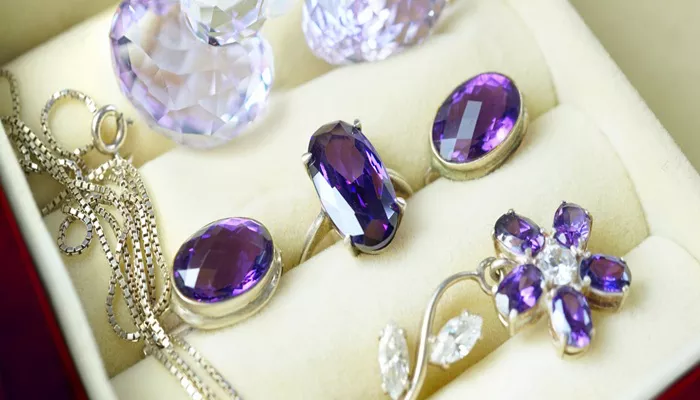Avoiding Physical Damage
Handle with Care: Emeralds and amethysts are relatively hard gemstones, but they can still be scratched or chipped. Always handle your necklace gently, especially when putting it on or taking it off. Avoid pulling or tugging on the necklace, as this can cause the stones to become loose or damaged. When you take off the necklace, place it in a safe and secure location, such as a jewelry box with individual compartments, to prevent it from coming into contact with other jewelry that could scratch it.
Remove During Physical Activities: It’s advisable to remove your emerald – amethyst necklace before engaging in any strenuous physical activities, such as sports, exercise, or household chores. The impact and friction from these activities can potentially damage the gemstones or the setting. For example, if you’re gardening, the dirt and debris can get stuck in the setting, and the movement can cause the stones to rub against each other or against hard surfaces. Also, when doing activities that involve using your hands a lot, like weightlifting, there’s a risk of accidentally hitting the necklace against something hard, which could lead to chips or cracks.
Beware of Sharp Objects: Keep your necklace away from sharp objects that could scratch the surface of the gemstones. This includes things like knives, scissors, and other metal tools. Even a small scratch can affect the light – reflecting properties of the gemstones and diminish their overall luster. If you need to store your necklace in a drawer, make sure there are no sharp – edged items in the same compartment.
Protecting from Chemicals
Avoid Contact with Cosmetics and Perfumes: Cosmetics, perfumes, hairsprays, and other beauty products can contain chemicals that may react with the surface of the gemstones and cause discoloration or dullness. Apply your makeup, perfume, and hairspray before putting on your necklace. Also, avoid wearing your necklace while using products like lotions and creams, as they can leave a residue on the stones that is difficult to remove. If the necklace does come into contact with these substances, wipe it clean immediately with a soft, dry cloth.
Keep Away from Household Cleaners: Household cleaners, such as bleach, ammonia – based products, and strong detergents, can be extremely harmful to gemstones. These chemicals can cause the gemstones to lose their color or become dull. When cleaning your home, remove your necklace to prevent any accidental contact with these cleaners. If you spill a cleaning product on your necklace, rinse it immediately with clean water and dry it gently with a soft cloth.
Remove Before Swimming: Chlorine – treated water, such as that in swimming pools, can damage the gemstones and the metal setting of your necklace. The chlorine can cause the metal to corrode and the gemstones to fade or become discolored. Always remove your necklace before swimming in a pool or hot tub. Similarly, if you’re going to be in salt water, like at the beach, it’s best to leave your necklace at home, as salt water can also have a negative impact on the gemstones over time.
Cleaning and Maintenance
Regular Gentle Cleaning: To keep your emerald – amethyst necklace looking its best, clean it regularly with a soft, damp cloth. Gently wipe the gemstones and the metal setting to remove any dirt, oil, or fingerprints. You can also use a mild soap solution if the necklace is particularly dirty. Mix a small amount of gentle dish soap with warm water and use a soft – bristled brush, such as a toothbrush, to carefully clean the necklace. Be sure to avoid getting the setting wet for extended periods, as water can seep into the setting and cause damage. After cleaning, rinse the necklace thoroughly with clean water and dry it with a soft, lint – free cloth.
Professional Cleaning and Inspection: It’s a good idea to have your necklace professionally cleaned and inspected at least once a year by a jeweler. Professional jewelers have the tools and expertise to clean the necklace more thoroughly, reaching areas that may be difficult to clean at home. They can also check the setting for any signs of wear or looseness and make any necessary repairs. This regular maintenance can help prevent small issues from becoming major problems and ensure the longevity of your necklace.
Storage in a Proper Environment: When storing your emerald – amethyst necklace, it’s important to keep it in a cool, dry place. Avoid storing it in direct sunlight or in areas with high humidity, as these conditions can cause the gemstones to fade or develop cracks. A jewelry box with a soft lining, such as velvet or satin, is ideal for storing your necklace. You can also use anti – tarnish strips in the jewelry box to help prevent the metal from tarnishing. Additionally, if you have multiple pieces of jewelry, store them separately to avoid scratching each other.
By following these daily care tips, you can ensure that your emerald – amethyst necklace remains beautiful and retains its value for years to come. Remember, proper care and maintenance are key to enjoying the beauty and elegance of your precious jewelry.
Related topics:
Who Should Not Wear Amethyst Crystals?
Can Pearl and Amethyst Create a Stunning Jewelry Combo?


